
This weapon was used on most US Treaty cruisers and the Lexington class carriers. None of these ships ever carried the "super-heavy" AP projectiles as their ammunition hoists could not accommodate the longer, heavier round.
As commissioned, the early cruisers had poor dispersion patterns, sometimes as large as 2,000 yards (1,830 m) for a full salvo. Some of these problems were due to the guns having a very high muzzle velocity and poor shot seating. Extensive testing to determine the cause of the problems was performed in 1933 at Manila Bay with the assistance of the Coast Artillery and the results sent to BuOrd. Corrections included reducing the muzzle velocity and relining the barrels.
These guns and mountings were removed from USS Lexington (CV-2) and USS Saratoga (CV-3) in 1942 and then reused as coastal artillery on the Island of Oahu, Hawaii. It had been planned to rearm these carriers with 5"/38 (12.7 cm) guns, but only Sarratoga actually received her new guns as Lexington was sunk before the work could be carried out.
This series of 8" (20.3 cm) guns were very heavy when compared to most other 8" (20.3 cm) guns for reasons that are not readily apparent. Mark 9 was the original design and was used on ships built in the 1920s. This gun consisted of liner, A tube, jacket, five hoops, three locking rings and a screw box liner. The Mark 10, which was never built, was a lighter gun constructed of only three hoops. Mark 11 had only one hoop and was autofretted. The Mark 13 was the Mark 9 relined with a partially chrome-plated bore. The Mark 14 was a relined Mark 9 with a fully chrome-plated bore and had a smaller chamber so that it could the same charges as used for the newer 8"/55 (20.3 cm) Mark 12 and Mark 15 guns. The Mark 14 was used for most regunnings during World War II but at least USS Minneapolis (CA-36) was regunned in 1945 with the Mark 15 Mod 1 which had adapter sleeves that allowed it to replace the older guns.
| Designation | 8"/55 (20.3 cm) Marks 9, 10, 11, 13 and 14 |
|---|---|
| Ship Class Used On | Lexington (CV-2), Pensacola (CA-24), Northampton (CA-26), New Orleans (CA-32, 34 and 36 only) and Portland (CA-33) classes |
| Date Of Design | 1922 |
| Date In Service | 1927 |
| Gun Weight | 30.0 tons (30.48 mt) |
| Gun Length | 449.0 in (11.405 m) |
| Bore Length | 440.1 in (11.179 m) |
| Rifling Length | 373.65 in (9.491 m) |
| Grooves | 64 (?) |
| Lands | N/A |
| Twist | Mark 9 Mods 0 to 3: Uniform RH 1 in 35
Mark 9 Mod 4: Uniform RH 1 in 30 Marks 10 and 11: Uniform RH 1 in 35 Mark 12 Mod 0: Uniform RH 1 in 35 Mark 12 Mod 1: Uniform RH 1 in 25 Mark 14: Uniform RH 1 in 25 |
| Chamber Volume | Marks 9, 10, 11 and 13: 5,300 in3 (86.8 dm3)
Mark 14: 4,860 in3 (79.6 dm3) |
| Rate Of Fire | 3 - 4 rounds per minute 1 |
- ^At the Battle of the Java Sea in February 1942, USS Houston (CA-30) was able to maintain a ROF of 5 - 6 rounds per minute during the early part of the battle, possibly through the use of "cue-balling" techniques.
| Type | Bag |
|---|---|
| Projectile Types and Weights | AP Mark 19 Mods 1 to 6: 260 lbs. (118 kg)
SP Common Mark 17 Mods 1 to 4 1a: 260 lbs. (118 kg) Common Mark 14 Mod 1 2a: 260 lbs. (118 kg) Common Mark 15 Mod 1 2a: 260 lbs. (118 kg) HC Mark 24 3a: 260 lbs. (118 kg) HC Mark 25 Mod 1 3a: 260 lbs. (118 kg) |
| Bursting Charge | AP Mark 19: 3.64 lbs. (1.7 kg) Explosive D
SP Common: 10.38 lbs. (4.7 kg) Explosive D Common Mark 14: 10.91 lbs. (4.9 kg) Explosive D Common Mark 15: 11.46 lbs. (5.2 kg) Explosive D HC Mark 24: 21.34 lbs. (9.7 kg) Explosive D HC Mark 25: 21.37 lbs. (9.7 kg) Explosive D |
| Projectile Length 4a | AP Mark 19: 36.0 in (91.4 cm)
SP Common: 36.0 in (91.4 cm) Common Mark 14: 34.0 in (86.4 cm) Common Mark 15: 36.0 in (91.4 cm) HC Mark 24: 34.56 in (87.8 cm) HC Mark 25: 34.61 in (87.9 cm) |
| Propellant Charge 5a | Marks 9, 10, 11 and 13 guns
Full Charge: 89 lbs. (40.4 kg) SPD 6a Full Flashless Charge: 92 lbs. (41.7 kg) SPCG Mark 14 guns
|
| Muzzle Velocity 7a | Marks 9, 10, 11 and 13 guns: 2,800 fps (853 mps)
Mark 14 guns only: 2,700 fps (823 mps) |
| Working Pressure | 17.0 tons/in2 (2,680 kg/cm2) |
| Approximate Barrel Life | 715 rounds |
| Ammunition stowage per gun 8a | 150 rounds |
- ^Special Common had a windscreen with a thin hood and the body was strengthened to enhance its armor piercing qualities.
- ^3.13.2HC projectile bodies could be used with Point Detonating (PD) or Mechanical Time (MT) fuzes. When used with PD fuzes, they were considered to be HC rounds. When used with MT fuzes, they were considered to be AAC rounds. MT fuzes were probably set by hand on the loading trays. HC Mark 25 was designed such that it could be forged from the base end.
- ^Radius of ogive for both AP Mark 19 and HC rounds was 83 inches (211 cm) or about 10crh. Bourrelet diameter of all rounds was 7.977 inches (20.3 cm).
- ^The propellant charges were in halves.
- ^Older guns appear to have used 90 lbs. (40.8 kg) SPD Full Charges.
- ^The Mark 9 originally had a muzzle velocity of 3,000 fps (914 mps), but barrel life was only about 500 rounds and accuracy was poor.
- ^Most of the 9-gun cruisers as commissioned had a peace-time outfit of 100 - 125 rounds per gun with a wartime allowance of 1,400 rounds per ship. During the early part of the war, the Northampton (CA-26) and Portland (CA-33) classes carried 1,500 rounds per ship, but this was reduced during refits after July 1942 to just over 1,300 rounds in order to allow for added AA weapons. The New Orleans (CA-32) class was reduced during refits after August 1942 to 125 rounds per gun. I do not have figures for the Pensacola (CA-24) class but I would assume that they had similar changes to their outfits.
| Elevation | Range | Angle of Fall | Time of Flight | Striking Velocity | Maximum Ordinate |
|---|---|---|---|---|---|
| 1.58 degrees | 4,000 yards (3,658 m) | 1.78 degrees | 4.66 seconds | 2,367 fps (417 mps) | N/A |
| 3.55 degrees | 8,000 yards (7,315 m) | 4.50 degrees | 10.23 seconds | 1,977 fps (603 mps) | N/A |
| 4.78 degrees | 10,000 yards (9,144 m) | 6.42 degrees | 13.43 seconds | 1,800 fps (549 mps) | N/A |
| 9.65 degrees | 16,000 yards (14,630 m) | 15.42 degrees | 25.25 seconds | 1,381 fps (421 mps) | N/A |
| 14.23 degrees | 20,000 yards (18,288 m) | 24.38 degrees | 35.23 seconds | 1,227 fps (374 mps) | N/A |
| 24.10 degrees | 26,000 yards (23,774 m) | 40.40 degrees | 53.92 seconds | 1,177 fps (359 mps) | N/A |
| 33.83 degrees | 30,000 yards (27,432 m) | 51.37 degrees | 70.60 seconds | 1,226 fps (374 mps) | N/A |
| 42.03 degrees | 32,000 yards (29,261 m) | 57.95 degrees | 83.45 seconds | 1,283 fps (391 mps) | N/A |
| 45.00 degrees | 32,330 yards (29,563 m) | 60.00 degrees | 87.98 seconds | 1,301 fps (397 mps) | N/A |
- ^Values for AP Mark 19, SP Common Mark 17 and Common Mark 15 from BuOrd OP 1188 page 29.
- ^This range table applies to those cruisers armed with Mark 9, Mark 11 and Mark 13 guns.
| Elevation | Range | Angle of Fall | Time of Flight | Striking Velocity | Maximum Ordinate |
|---|---|---|---|---|---|
| 1.57 degrees | 4,000 yards (3,658 m) | 1.77 degrees | 4.66 seconds | 2,370 fps (722 mps) | 87 ft (27 m) |
| 4.80 degrees | 10,000 yards (9,144 m) | 6.52 degrees | 13.48 seconds | 1,772 fps (540 mps) | 730 ft (223 m) |
| 9.78 degrees | 16,000 yards (14,630 m) | 16.13 degrees | 25.61 seconds | 1,317 fps (401 mps) | 2,640 ft (805 m) |
| 14.63 degrees | 20,000 yards (18,288 m) | 26.27 degrees | 36.13 seconds | 1,147 fps (350 mps) | 5,295 ft (1,614 m) |
| 25.13 degrees | 26,000 yards (23,774 m) | 43.72 degrees | 56.05 seconds | 1,147 fps (350 mps) | 12,940 ft (3,944 m) |
| 35.67 degrees | 30,000 yards (27,432 m) | 54.78 degrees | 73.98 seconds | 1,175 fps (358 mps) | 22,490 ft (6,855 m) |
| 45.00 degrees | 31,982 yards (29,244 m) | 61.35 degrees | 88.69 seconds | 1,235 fps (376 mps) | 31,900 ft (9,723 m) |
- ^Values for HC Mark 24 and HC Mark 25 from BuOrd OP 1188 page 33.
- ^This range table applies to those cruisers armed with Mark 9, Mark 11 and Mark 13 guns.
| Elevation | Range | Angle of Fall | Time of Flight | Striking Velocity | Maximum Ordinate |
|---|---|---|---|---|---|
| 1.71 degrees | 4,000 yards (3,658 m) | 1.92 degrees | 4.86 seconds | 2,267 fps (691 mps) | 95 ft (29 m) |
| 5.22 degrees | 10,000 yards (9,140 m) | 7.03 degrees | 14.03 seconds | 1,724 fps (525 mps) | 795 ft (242 m) |
| 10.55 degrees | 16,000 yards (14,630 m) | 16.80 degrees | 20.41 seconds | 1,340 fps (408 mps) | 2,834 ft (864 m) |
| 14.64 degrees | 20,000 yards (18,290 m) | 26.43 degrees | 36.91 seconds | 1,197 fps (365 mps) | 5,600 ft (1,707 m) |
| 22.40 degrees | 24,000 yards (21,946 m) | 37.43 degrees | 49.46 seconds | 1,165 fps (355 mps) | 10,130 ft (3,088 m) |
| 39.03 degrees | 30,000 yards (27,430 m) | 55.00 degrees | 76.88 seconds | 1,250 fps (381 mps) | 24,455 ft (7,454 m) |
| 41.92 degrees | 30,500 yards (27,889 m) | 57.25 degrees | 81.18 seconds | 1,268 fps (386 mps) | 26,950 ft (8,214 m) |
- ^Values for AP Mark 19, SP Common Mark 17 and Common Mark 15 from BuOrd OP 1188 page 30.
- ^This range table applies to those cruisers rearmed with the 8"/55 (20.3 cm) Mark 14 guns.
| Elevation | Range | Angle of Fall | Time of Flight | Striking Velocity | Maximum Ordinate |
|---|---|---|---|---|---|
| 1.70 degrees | 4,000 yards (3,658 m) | 1.90 degrees | 4.84 seconds | 2,273 fps (693 mps) | 94 ft (29 m) |
| 3.88 degrees | 8,000 yards (7,315 m) | 4.98 degrees | 10.68 seconds | 1,868 fps (569 mps) | 458 ft (140 m) |
| 5.23 degrees | 10,000 yards (9,144 m) | 7.20 degrees | 14.09 seconds | 1,686 fps (514 mps) | 799 ft (244 m) |
| 6.79 degrees | 12,000 yards (10,973 m) | 9.97 degrees | 17.90 seconds | 1,521 fps (463 mps) | 1,290 ft (393 m) |
| 10.75 degrees | 16,000 yards (14,630 m) | 17.83 degrees | 26.93 seconds | 1,376 fps (419 mps) | 2,926 ft (892 m) |
| 16.20 degrees | 20,000 yards (18,288 m) | 28.78 degrees | 38.13 seconds | 1,120 fps (341 mps) | 5,913 ft (1,802 m) |
| 19.62 degrees | 22,000 yards (20,117 m) | 34.82 degrees | 44.57 seconds | 1,107 fps (337 mps) | 8,136 ft (2,480 m) |
| 28.22 degrees | 26,000 yards (23,774 m) | 46.58 degrees | 59.52 seconds | 1,131 fps (345 mps) | 14,676 ft (4,473 m) |
| 42.10 degrees | 30,000 yards (27,432 m) | 58.77 degrees | 81.63 seconds | 1,203 fps (367 mps) | 27,227 ft (8,299 m) |
| 45.00 degrees | 30,360 yards (27,761 m) | 60.70 degrees | 85.92 seconds | 1,221 fps (372 mps) | 30,028 ft (9,153 m) |
| Range | Side Armor | Deck Armor |
|---|---|---|
| 9,000 yards (8,230 m) | 10.0" (254 mm) | --- |
| 12,400 yards (11,340 m) | 8.0" (203 mm) | --- |
| 13,500 yards (12,340 m) | --- | 1.0" (25 mm) |
| 16,600 yards (14,630 m) | 6.0" (152 mm) | --- |
| 17,600 yards (16,090 m) | --- | 1.5" (38 mm) |
| 19,500 yards (17,830 m) | 5.0" (127 mm) | --- |
| 21,200 yards (19,390 m) | --- | 2.0" (51 mm) |
| 23,600 yards (21,580 m) | 4.0" (102 mm) | --- |
| 26,400 yards (24,140 m) | --- | 3.0" (76 mm) |
| 29,600 yards (27,070 m) | 3.0" (76 mm) | --- |
| 30,200 yards (27,610 m) | --- | 4.0" (102 mm) |
- These figures are taken from armor penetration curves issued in 1942 as shown in "US Naval Weapons."
| Designation 1g | Twin Mounts 2g Lexington (4) Pensacola (2) Triple Mounts 3g Triple Turrets, 4g |
|---|---|
| Weight | Twin Mounts: 187 tons (190 mt)
Triple Mounts: 247 - 250 tons (251 - 254 mt) Triple Turrets: 294 tons (299 mt) |
| Elevation | -10 / +41 degrees |
| Elevation Rate | 8 degrees per second |
| Train | about +150 / -150 degrees |
| Train Rate | about 3.5 degrees per second |
| Gun recoil | 29.65 in (75.3 cm) |
| Loading angle | Mounts: +5 degrees
Turrets: +9 degrees |
- ^There were two different kinds of mountings. The earliest ones were officially classified as "twin mounts" and "triple mounts" rather than "turrets," as they had handling rooms directly below the gunhouse and did not have a rotating stalk. The later mountings used on New Orleans (CA-32), Astoria (CA-34) and Minneapolis (CA-36) were classified as "triple turrets" as they did have a rotating stalk. All of these mountings had the guns in a single sleeve.
- ^The carrier twin mountings were different in design than those used on cruisers and appear similar to the twin 6" (15.2 cm) mounts used on the Omaha (CL-4) class.
- ^The shell and charge hoist arrangements in the earlier twin and triple mountings were similar to the later turrets, but the lower hoists were part of the fixed structure. The triple mounting in the Pensacola class (CA-24) had a 15 hp elevating motor and in all ships the upper charge hoists were powered by 3.5 hp motors while the lower ones were powered by 5 hp motors. The twin mountings were similar but had a 20 hp training motor and a 10 hp elevating motor.
- ^All mountings and turrets were electrically powered through hydraulic gear. The triple turret had a 30 hp training motor and an 18 hp motor that elevated the gun cradle. Each gun had a 7.5 hp ramming motor and a 7 hp motor for its pusher shell hoist. Each gun had a shell hoist in the stalk which ran directly from the shell room to the gun breech. There were two lower powder hoists that ran from the magazine to the handling room and were each powered by a 15 hp motor. The upper powder hoists were powered by six 1.5 hp motors. Shells were stored vertically on the fixed structure.
- RPC was used in the New Orleans class as built. RPC was fitted to surviving ships during World War II, except for Salt Lake City (CA-25).
- The gun axes were about 46 in (117 cm) apart for all mounting types.
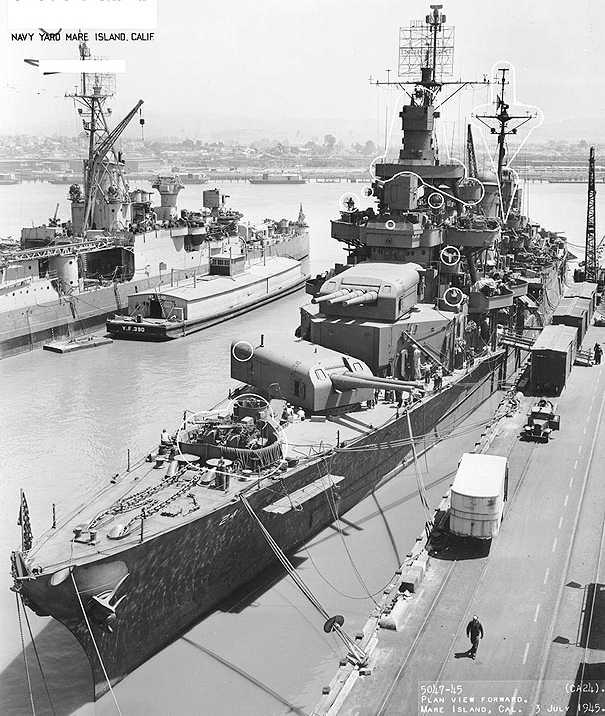
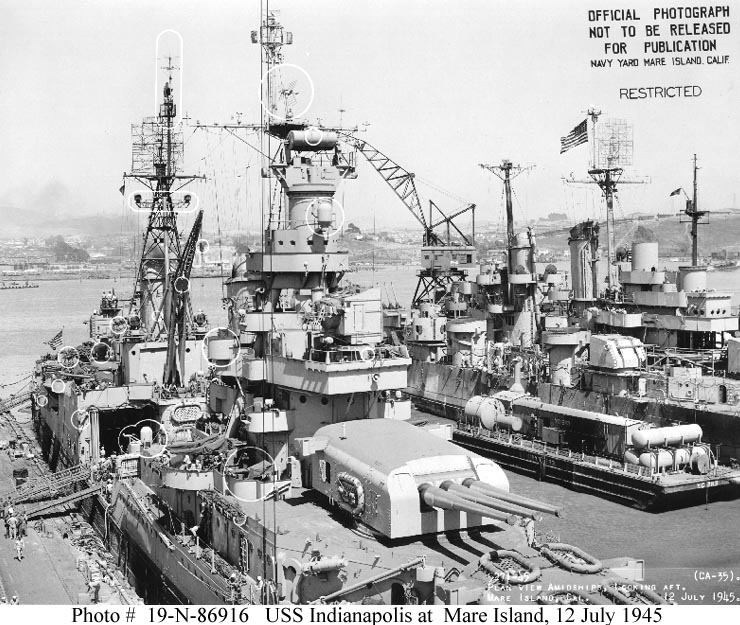
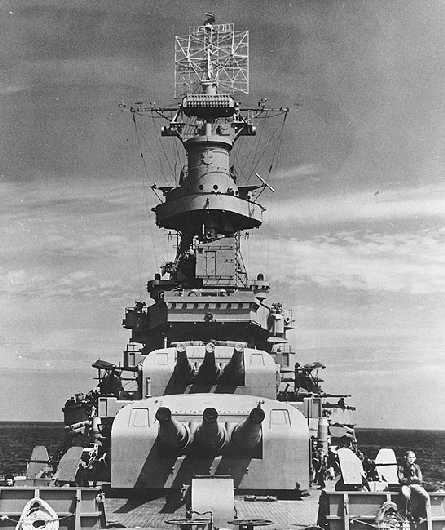
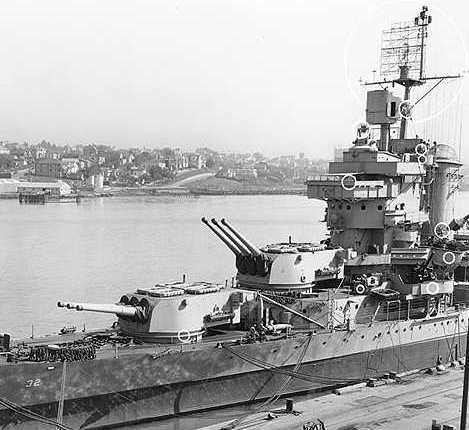
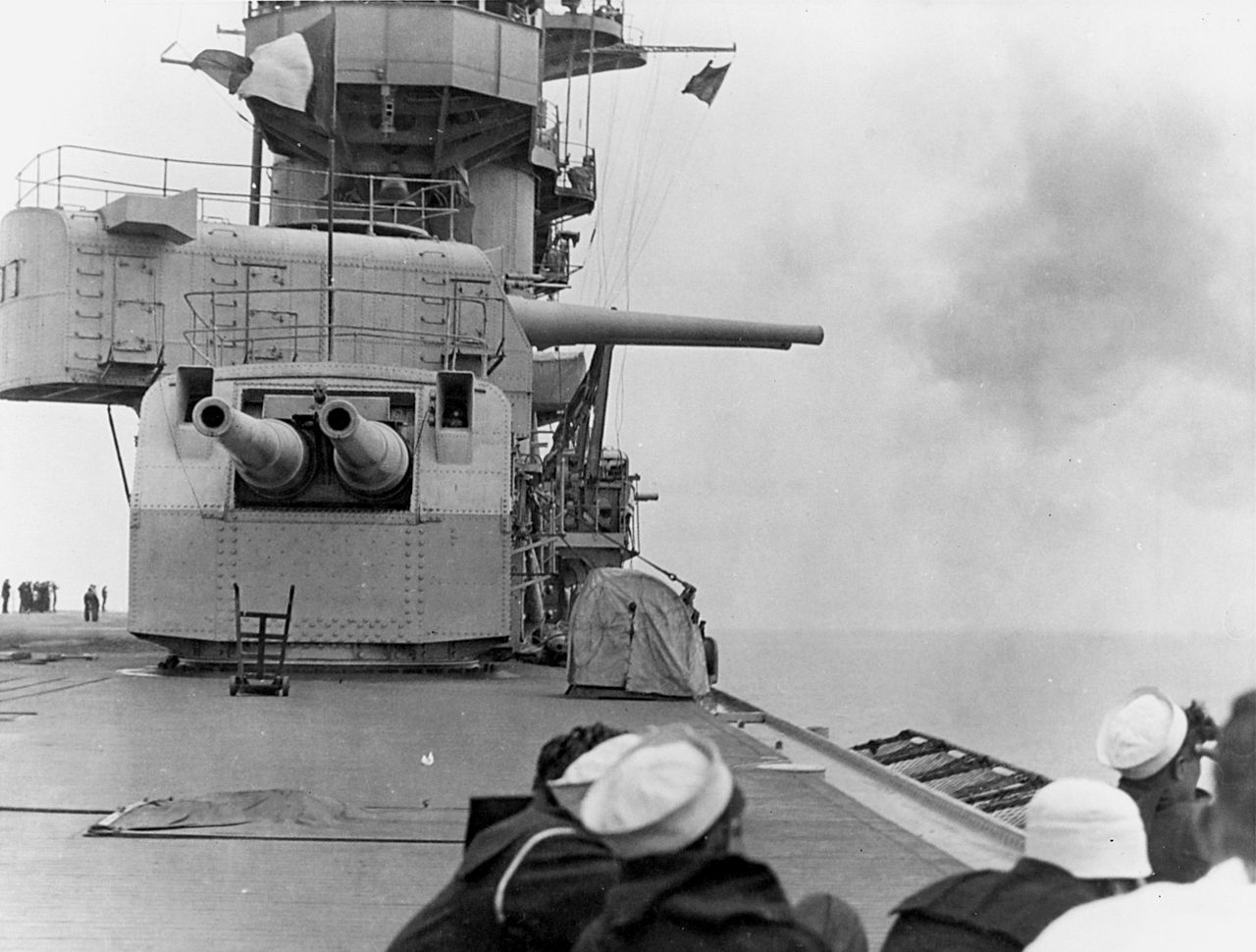
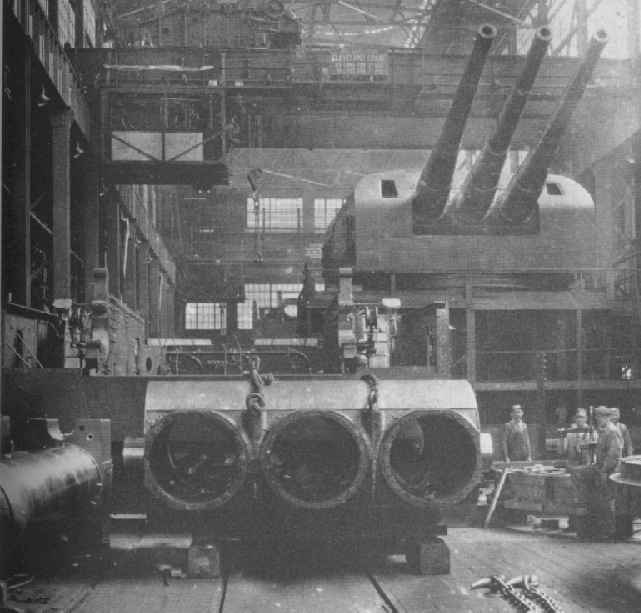
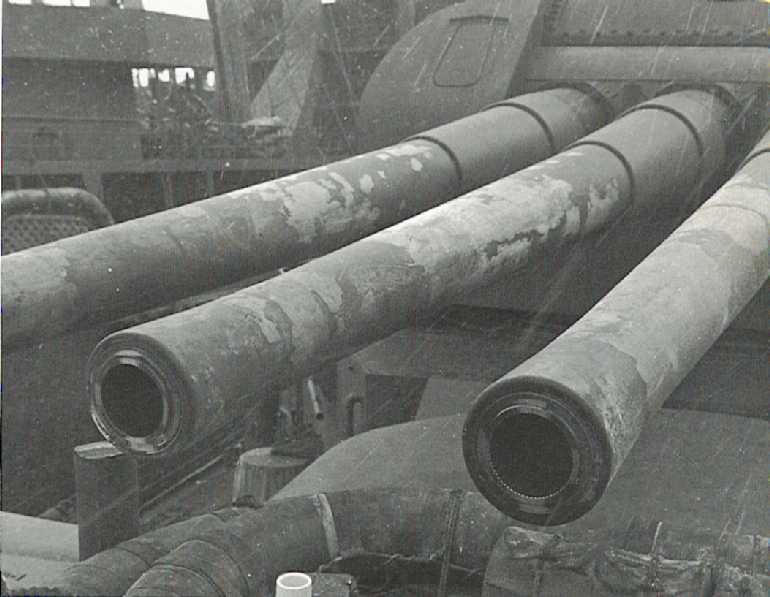
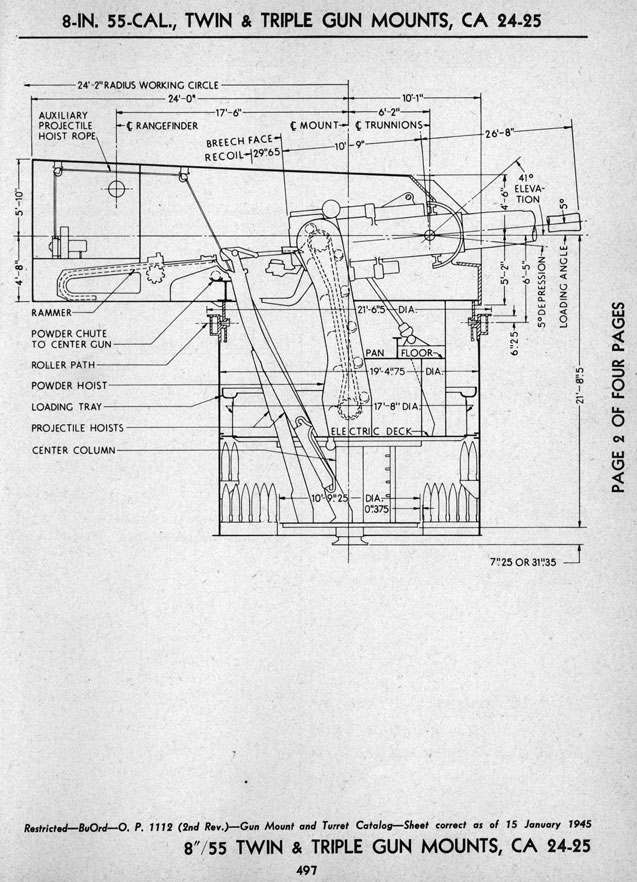
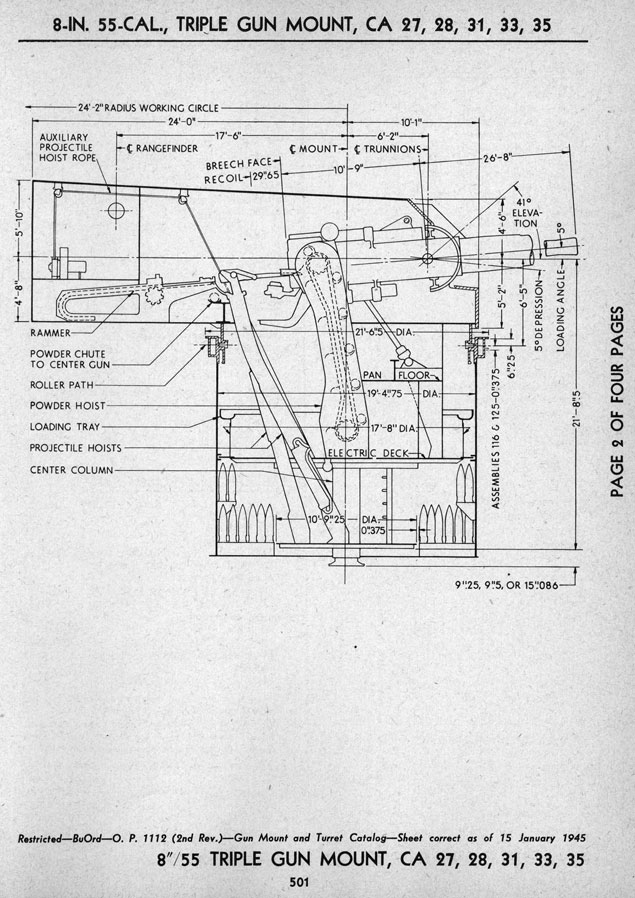
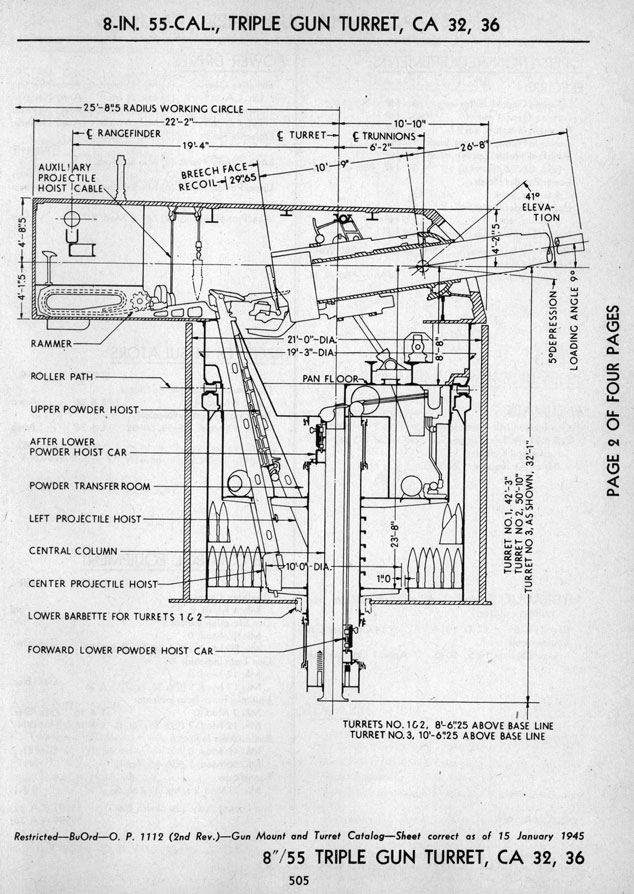
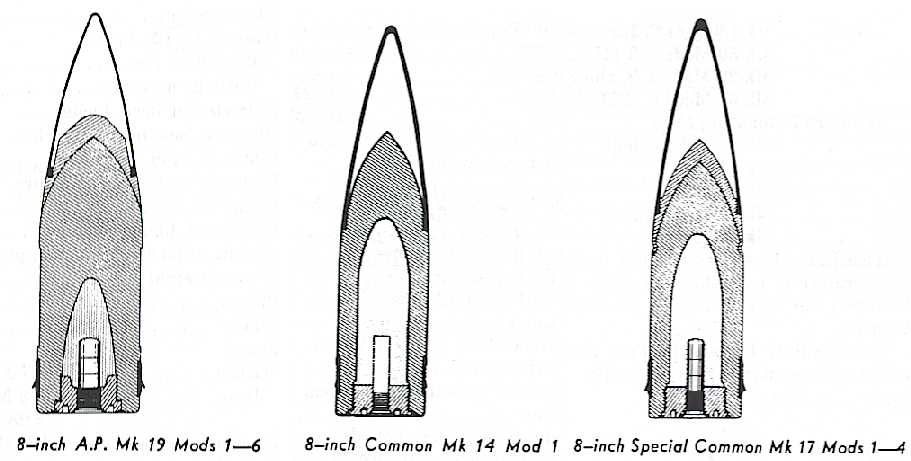
For an article on the mountings removed from USS Lexington CV-2 and USS Saratoga CV-3, see Gene Slover's Navy Pages for Oahu’s 8-inch Naval Turret Batteries 1942-1949
"Naval Weapons of World War Two" by John Campbell
"US Cruisers: An Illustrated Design History" and "US Naval Weapons" both by Norman Friedman
"Ship of Ghosts: The Story of the USS Houston" by James D. Hornfischer
"Round Shot to Rockets: A History of the Washington Navy Yard and the United States Naval Gun Factory" by Taylor Peck
"Cruisers of World War Two" by M.J. Whitley
---
"Abridged Range Tables for U.S. Naval Guns - Ordnance Pamphlet No. 1188 - 13 June 1944" by Bureau of Ordnance (BuOrd), Department of the Navy
"U.S. Explosive Ordnance - Ordnance Pamphlet No. 1664 - May 1947" by Bureau of Ordnance (BuOrd), Department of the Navy
---
Personal reminisces of Vice-Admiral William P. Mack, Gunnery Officer aboard USS John D. Ford (DD-228) during Battle of Java Sea
---
Gene Slover's Navy Pages
---
Special help from Leo Fischer
12 February 2008 - Benchmark
19 May 2009 - Added picture of Pensacola
24 January 2011 - Deleted references to the AP Mark 16
27 April 2011 - Added note about ammunition stowage
23 July 2011 - Added additional information regarding ammunition stowage
09 May 2014 - Added link regarding use as coastal batteries on Oahu
13 May 2016 - Corrected typographical error
06 July 2016 - Converted to HTML 5 format
25 April 2018 - Reorganized notes
18 October 2018 - Changed elevation rate
31 December 2018 - Added turret sketches
28 May 2021 - Corrected typographical error and added some ammunition information
10 August 2023 - Revised range tables and added comments about Mark 14 guns having a smaller chamber and a lower MV
11 March 2025 - Added sketch for CA-32 and comment about USS Minneapolis (CA-36) using the Mark 15 Mod 1 for regunning
